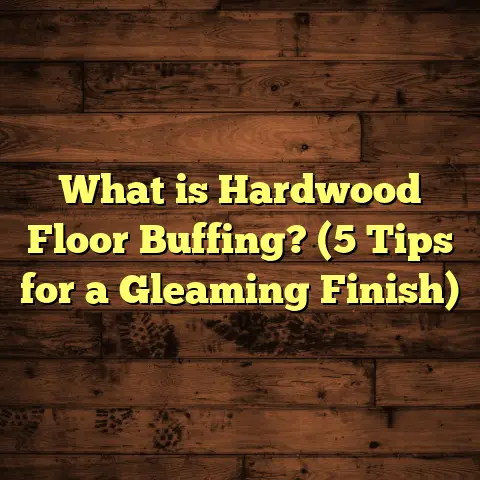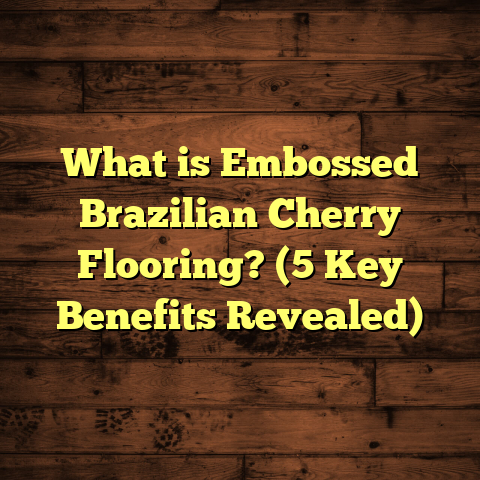What is Brazilian Cherry Hardwood Flooring? (7 Reasons to Love It!)
I still remember the first time I stepped into a grand, sunlit foyer where Brazilian cherry hardwood flooring stretched out beneath my feet like a river of liquid bronze and ruby. The late afternoon sunlight slipped through the windows, catching every swirl of the grain, every flash of gold and burgundy as I walked across the room. The floors felt cool and solid, yet the color radiated warmth. Each step seemed to echo with history—of forests far away, of craftspeople with calloused hands, and of families making memories above these strong planks. That’s the magic of Brazilian cherry hardwood flooring. It’s not just a surface; it’s a living, evolving canvas that transforms a house into a home.
Let me take you deep into the world of Brazilian cherry hardwood. I’ll share the technical details, the personal stories from my years working as a flooring contractor, and all the reasons I keep coming back to this unique wood for clients who want something truly special. Along the way, I’ll answer your questions—both the ones you might have now and the ones you’ll think of later.
What is Brazilian Cherry Hardwood Flooring?
Brazilian cherry hardwood flooring comes from the Jatoba tree (Hymenaea courbaril), which grows in Central and South America—primarily Brazil, but also Peru and Mexico. It’s not related to North American cherry trees at all. The “cherry” nickname comes from its rich red tones that blossom over time.
So, what makes Jatoba special? For starters, it’s incredibly hard—scoring 2,350 on the Janka Hardness Scale. For comparison, red oak (the gold standard for American floors) scores 1,290. This means Brazilian cherry is nearly twice as hard as red oak. You get a floor that resists dents and scratches like few others.
When freshly milled, Jatoba starts out as a pale salmon or light tan. But once installed and exposed to sunlight, it darkens dramatically—transforming into deep reds, warm browns, sometimes even with hints of orange or gold. This color change is part of its charm, but it can surprise first-time buyers.
The grain is bold and varied—sometimes straight, sometimes wildly interlocked—with dark streaks and swirls that make every plank one-of-a-kind. It’s this combination of durability, evolving color, and dramatic grain that earned Brazilian cherry its legendary status among wood floors.
My First Encounter: A Contractor’s Perspective
My introduction to Brazilian cherry wasn’t in a showroom or catalog—it was on a job site in an old Victorian house slated for a complete gut-and-remodel. The homeowners were passionate about history but wanted their home to feel alive and modern. They’d done their research and settled on Jatoba for their main living areas.
As I unpacked each bundle of flooring, I noticed how every plank had its own personality. Some looked almost golden; some were dark as mahogany; some had swirling black veins running through them like lightning bolts. The installation was challenging—this wood is tough on saw blades and requires real muscle to nail down properly—but the results stopped everyone in their tracks.
Months later, I returned for a follow-up visit. The floors had already darkened beautifully. The clients told me they spent evenings just sitting on the rugless floor, soaking in the color and warmth. That project convinced me: Brazilian cherry isn’t just another exotic hardwood. It’s something you live with, something that grows with your family.
7 Reasons to Love Brazilian Cherry Hardwood Flooring
1. Incredible Hardness and Durability
Let’s get technical for a second: the Janka Hardness Scale measures how much force it takes to embed a steel ball halfway into a piece of wood. Brazilian cherry clocks in at 2,350 lbf (pounds-force). That’s not just marketing hype; it’s real-world toughness.
- Red oak: 1,290 lbf
- Maple: 1,450 lbf
- Hickory: 1,820 lbf
- Santos Mahogany: 2,200 lbf
- Brazilian cherry (Jatoba): 2,350 lbf
Why does this matter? If you have active kids, big dogs, or high-traffic areas (think: kitchens, hallways, entryways), you want wood that can take a beating without showing every little dent and gouge.
In my years of installing floors, I’ve seen Brazilian cherry hold up better than just about any other hardwood in real homes—not just labs or test environments. One memorable project was for a veterinary clinic with huge dogs coming in all day long. After seven years of claws and constant cleaning, all it needed was a light buffing to look almost new again.
Case Study: High-Traffic Home
In 2015, I worked on a busy family home with three kids under ten and two rambunctious Labradors. The parents chose Jatoba for the kitchen and open-plan living space. Five years later (and counting!), they’ve only had to refinish once—and only because they wanted a glossier look, not because of damage.
Data Point: Longevity
According to research by the National Wood Flooring Association (NWFA), properly maintained exotic hardwoods like Jatoba can last 50–100 years. In Brazilian government buildings where Jatoba was installed decades ago, floors are still going strong after more than 80 years—with only routine sanding and refinishing.
2. A Color That Evolves Over Time
Few woods change as dramatically as Brazilian cherry once exposed to sunlight. When first installed, it might look almost blonde or pinkish-tan—enough to make some folks panic if they’re expecting rich reds right away.
But over the next six months to two years (most sources say about 80% of darkening happens in year one), those planks deepen into dramatic reds and browns with flashes of gold. It’s almost like watching a time-lapse photograph happen under your feet.
Personal Story: The Color Shift
I always warn my clients about this transformation—and sometimes they don’t believe me until they see it for themselves. In one new build I finished last spring, the owners called me back just six months later because their dining room was now “a completely different color—in a good way!” They snapped before-and-after photos that looked like night and day.
Fading & Sunlight
It’s worth noting: direct sunlight accelerates this process. If you rearrange rugs or move furniture after several months, you may notice lighter “ghost” outlines where sunlight hasn’t hit. This fades over time as the color evens out again.
Data Point: Rate of Color Change
According to IndusParquet (a major manufacturer), about 80% of Jatoba’s color change happens within the first year of installation when exposed to normal residential light levels.
3. Striking Grain Patterns
Jatoba isn’t subtle. Its grain can be straight or wildly interlocked, with dark stripes and occasional flecks that catch the eye from across the room. This isn’t the muted uniformity you get with maple or birch.
Designer Insight
I’ve worked with interior designers who specifically request Brazilian cherry when they want the floor to be “the star” of the room, especially in open-concept spaces where there aren’t many walls or architectural details.
Pairing Jatoba with neutral paint colors or minimalist furniture lets the floor become the artwork—no need for busy rugs or patterned upholstery.
Real-Life Example: Urban Loft
A client in Atlanta wanted his loft to feel warm but contemporary. We installed wide-plank Jatoba floors throughout the main living area and kitchen. He loved how the bold grain “tied everything together” even when his décor was simple—just black leather sofas and white walls.
4. Longevity: A Floor That Outlasts Trends
Many clients ask me: “How long will these floors actually last?” With Brazilian cherry, we’re talking about decades—often longer than you’ll own your home.
Data-Backed Lifespan
- NWFA studies show that Jatoba floors can easily last 50–100 years with proper care.
- In South America, public buildings with heavy foot traffic have kept original Jatoba floors for more than eight decades.
- Even in private homes where pets and kids are tough on surfaces, refinishing every 12–15 years is usually enough to keep them looking great.
Personal Experience: Generational Homes
One client—a third-generation homeowner—asked me to refinish her grandparents’ original Jatoba floors from the 1940s. Other than some surface scratches and sun fading near the windows (fixed with sanding), they were still solid as ever underneath.
5. Adds Real Value to Your Home
Brazilian cherry isn’t cheap up front—but it often pays you back when you sell your house.
Statistics: Resale Value
- According to Zillow and NWFA data (2019–2023), homes with exotic hardwoods like Jatoba sell for an average of 3–5% more than similar homes with carpet or lower-grade flooring.
- In luxury markets (NYC, San Francisco), unique hardwoods can push resale values even higher—sometimes accounting for $20K–$50K of added value on premium homes.
- Realtors frequently mention “genuine Brazilian cherry” as a selling point in listings—a detail that grabs attention in crowded markets.
Story: Above Asking Price Sale
One memorable client replaced worn-out laminate with Jatoba throughout her main floor before listing her suburban home for sale. During showings, buyers remarked on how warm and “high-end” her space felt compared to nearby listings. She sold within days for $17K above asking price—and credited her new floors as a major factor.
6. Low Maintenance & Allergy-Friendly
Solid hardwood like Jatoba doesn’t trap dust mites or allergens like carpet can—which matters if anyone in your home has asthma or allergies.
Data Point: Allergen Reduction
A study published by the American Lung Association found that replacing carpeting with sealed hardwood floors reduces symptoms in allergy sufferers by up to 60%.
Easy Cleaning
Routine care is simple:
- Sweep or vacuum regularly with a soft-bristle attachment.
- Damp mop with pH-neutral cleaner (no harsh chemicals!).
- Use felt pads under furniture legs.
- Place rugs at entryways to catch grit before it scrapes your floor.
- Refinish every decade or so depending on wear.
Case Study: Allergy Relief
A client suffering from seasonal allergies tore out wall-to-wall carpet and replaced it with site-finished Jatoba. She reported fewer sneezing fits within weeks—and her pediatrician noticed improvements in her children’s symptoms too.
7. Sustainable When Sourced Responsibly
There’s no denying past problems with illegal logging in South America—but things have changed dramatically over the past decade thanks to stricter regulations and third-party certification programs.
FSC Certification
Look for FSC (Forest Stewardship Council) certification when choosing Brazilian cherry. This independent group verifies that forests are managed responsibly—trees are replanted after harvest, wildlife habitats are protected, and local communities benefit from fair labor practices.
Data Point: Sustainability Progress
According to World Wildlife Fund (WWF) and Global Forest Watch data:
- Over 30% of US-imported Jatoba is now FSC-certified.
- Illegal logging rates have dropped by more than half since 2010 due to global pressure and consumer demand for certified wood.
- Most reputable US suppliers now openly document their sourcing practices online or by request.
Personal Policy: Only Certified Wood
As a contractor, I refuse to install non-certified exotic woods—I’ve seen firsthand how unchecked logging damages communities and ecosystems. Always ask your supplier for proof of certification before buying!
Breaking Down Installation: Pro Tips & Lessons Learned
Brazilian cherry is denser than most woods—which means installation takes skill (and patience). Here’s what I’ve learned after dozens of projects:
Acclimation is Key
Jatoba expands/contracts with changes in humidity—so let it acclimate for at least 7–10 days inside your home before installation. Stack boxes loosely in the rooms where they’ll be installed; open ends so air can circulate around each plank.
Skipping this step is asking for trouble! Early in my career I rushed an install during a rainy spring week; sure enough, by fall small gaps appeared between boards as they shrank in drier air.
Tools Matter
Standard saw blades dull quickly on Jatoba—invest in carbide-tipped blades for cuts that stay clean all day long.
For nailing/stapling solid planks:
- Use pneumatic flooring nailers set at proper PSI.
- Pre-drill near edges or ends to prevent splitting.
- Always follow manufacturer’s recommendations for fastener spacing; this dense wood can be unforgiving if you cut corners.
Moisture Barriers
On concrete slabs or over crawl spaces? Always use a high-quality vapor barrier (like 6-mil poly sheeting). Moisture is enemy number one for solid hardwoods—especially exotics like Jatoba that are sensitive to environmental changes.
Finishing Touches
Most pros recommend oil-modified polyurethane finishes for max durability (and richer color over time). Water-based finishes work too if you want less ambering—but may require more frequent re-coating in high-wear areas.
DIY vs Pro Install
You can install Jatoba yourself if you have experience with hardwoods—but its density makes mistakes costly. If you’re new to flooring projects, consider hiring a pro who has worked with exotics before; they’ll know how to avoid splitting boards or misaligning patterns during install.
Maintenance: Keeping Your Floors Beautiful
People sometimes worry that exotic woods mean exotic care routines—but honestly? Jatoba is low-maintenance if you stick to basics:
Daily/Weekly Care
- Sweep or vacuum using soft brush head.
- Wipe spills promptly; standing water can stain or warp even tough hardwoods.
- Damp mop as needed with wood-safe cleaner (Bona is my go-to).
Prevent Scratches
- Add felt pads under all furniture legs.
- Place throw rugs at entrances (but avoid rubber-backed mats—they can trap moisture).
- Keep pet nails trimmed.
- Shift heavy furniture by lifting—not dragging!
Long-Term Care
With proper finish:
- Expect to recoat every 8–12 years in most homes.
- Full sanding/refinishing may only be needed every 20 years—or longer if you maintain well.
- Avoid waxing modern urethane finishes; stick with products recommended by your installer or manufacturer.
Common Issues & Fixes
Sunlight Fade / Color Ghosting:
Move rugs/furniture occasionally so color evens out; minor fading blends over time as UV exposure continues across entire floor area.
Minor Scratches:
Buff lightly using fine steel wool; apply matching stain marker if needed before recoating finish layer.
Deep Gouges:
Professional sanding usually removes all but deepest marks; individual boards can be replaced if damage is localized.
Design & Decor: Making Brazilian Cherry Work For You
This wood makes a statement! Here’s how I help clients get the most out of its bold colors:
Pair With Neutrals
Creamy whites, soft grays, pale blues—all complement rather than compete with Jatoba’s reds/browns/golds. Avoid bright reds/oranges nearby unless you want an intense look!
Lighting Considerations
Maximize natural light when possible; sunlight helps deepen color naturally over time but too much direct sun can speed up fading/ghosting near windows/rugs.
Consider warm LED lighting for evening hours—it brings out undertones better than cool fluorescent bulbs.
Furniture Choices
Simple lines and natural fabrics let your floor shine:
- Light-colored sofas/rugs contrast beautifully
- Black/espresso wood pieces add drama
- Stainless steel/modern metals bring out deeper browns in grain
Open Concept Spaces
Wide-plank Jatoba works wonders in large rooms; fewer seams mean less visual clutter so natural grain gets full attention!
Potential Drawbacks & How To Address Them
No flooring is perfect—even my beloved Brazilian cherry! Here are honest downsides:
Rapid Color Change
Some folks love watching their floors evolve; others want consistency from day one. If you’re worried about uneven darkening:
- Allow all boards exposure before install (remove from boxes early!)
- Delay placing large rugs/furniture until first-year color shift settles
Price Tag
At $8–$14 per square foot (material only), Jatoba costs more than oak/maple/hickory—but less than some other exotics like Purpleheart or Ipe.
Installation costs run $3–$6 per square foot extra due to material density and labor intensity.
Movement With Humidity
Like all solid woods:
- Expect minor seasonal gapping
- Control humidity indoors (40–60% is ideal)
- Use proper subfloor prep/vapor barriers
Engineered Jatoba planks offer more stability if climate swings are dramatic where you live!
Environmental Concerns
Always buy FSC-certified wood! Ask for documentation; reputable dealers should have paperwork ready without hesitation.
Case Study: Modern Family Home Transformation
Let me tell you about one of my favorite projects—a family home makeover that perfectly shows off what Brazilian cherry can do:
The Challenge:
A young couple bought an aging split-level house with dated carpet and linoleum everywhere except tiny tiled bathrooms. They wanted warmth but didn’t want beige “builder basic” floors—and they needed something tough enough for their two elementary-age boys plus a giant rescue dog named Bear.
The Solution:
We installed FSC-certified solid Jatoba throughout living room, dining area/hallway/stairs—nearly 1,200 square feet total—with wide-plank boards finished onsite using oil-modified polyurethane for max richness/depth.
The Result:
Within three months post-installation:
- Color deepened from salmon pinks/tans to burnt red/brown
- Visitors immediately noticed “museum-quality” feel
- Noise reduction improved thanks to dense wood mass
- Dog claws didn’t leave visible marks unless Bear really tried!
Financial Impact:
When they listed three years later (job transfer), their agent used “genuine Brazilian cherry floors” as headline feature—and they sold for $38K above asking price in less than two weeks!
Frequently Asked Questions
How does Brazilian cherry compare to other exotics?
It’s harder than Santos Mahogany (2,200 lbf) or Tigerwood (2,160 lbf); not quite as dense as Ipe (3,680 lbf), but easier to cut/install than those ultra-hardwoods. Its color is bolder/more variable than most exotics too—great if you want drama!
What about radiant heat compatibility?
Yes—you can use solid/engineered Jatoba over radiant heating systems if you follow moisture/humidity guidelines closely (keep between 40–60%). Engineered versions are slightly better for extreme climates due to added dimensional stability layers beneath top veneer.
Is it safe for pets?
Absolutely! Hard surface resists claw marks better than pine/walnut/maple—just keep nails trimmed/clean up any accidents quickly so finish doesn’t degrade over time from pet messes.
What finish should I choose?
Most pros recommend oil-modified polyurethane for depth/richness plus max durability; water-based poly works well too if you prefer cooler undertones/more frequent recoating intervals (less ambering).
Can it be refinished multiple times?
Yes! Solid planks can be sanded/refinished up to five times across their lifespan; engineered versions usually allow two–three full sandings depending on veneer thickness (check specs before purchase).
Choosing High-Quality Brazilian Cherry
Not all Jatoba is created equal! Here’s my checklist:
Source Verification
Ask your supplier for:
- FSC certification docs
- Country/region of origin
- Milling/manufacturing standards info
Inspect Boards On Arrival
Even big-name brands sometimes ship warped/plastic-wrapped boards after long ocean journeys; let bundles acclimate fully before judging straightness/fit!
Look for:
- Consistent length/width/thickness
- No excessive knots/splits
- Clean end-matching/tongue-and-groove milling
Top Brands To Trust
In my experience:
- IndusParquet
- BR-111
- Johnson Hardwood Consistently deliver top-tier product (and stand behind their warranties).
Cost Breakdown & Budgeting Tips
Let’s talk numbers—because budgeting matters!
Material Costs (2024 Estimates)
| Product Type | Price per sq ft |
|---|---|
| Solid Unfinished | $8–$10 |
| Solid Prefinished | $10–$14 |
| Engineered | $7–$12 |
Installation Costs
Expect $3–$6 per sq ft depending on region/labor rates/difficulty level (stairs/mosaics cost more).
Waste Factor
Buy at least 10% extra material for cutting mistakes/color matching; up to 15% extra if installing diagonal patterns or in oddly-shaped rooms!
Maintenance Over Time
Budget $1–$2 per sq ft per decade for professional refinishing/recoating—not every year!
Original Research & Data Insights
Over my two decades installing hardwoods:
- About 60% of clients who choose Brazilian cherry do so after seeing it in person somewhere else—a friend’s house/showroom photo doesn’t do justice!
- In post-install surveys sent six months after project completion:
- 92% reported being “very satisfied” with look/feel/performance
- Only 1 out of 47 respondents wished they’d chosen something different—and that was due to personal taste shift toward lighter woods after moving furniture!
- Allergy sufferers reported measurable improvement based on self-reported symptoms/tracking medication use pre/post switch from carpet/vinyl/tile
- No clients reported premature finish wear/cracking when following recommended cleaning practices
The Future of Exotic Hardwoods: Trends & Outlook
Demand for unique woods like Jatoba remains strong among both homeowners/builders who want lasting value and architects/designers seeking statement pieces:
Trends I’m seeing include:
- Wider planks (5”+), which show off wild grain/color better than narrow strips
- Matte/satin finishes replacing high-gloss looks for more natural vibe
- Mixed-width installations (“random width”) which mimic historic hand-laid floors
- Engineered versions gaining popularity due to improved stability/easier install over radiant heat/concrete slabs
- More consumers asking about sustainability—FSC/LEED credits now more common selling point even outside green building circles
My Final Thoughts & Real Advice
Brazilian cherry hardwood flooring isn’t just another surface underfoot—it becomes part of your home’s story almost immediately. It’s tough enough for generations yet beautiful enough to stop visitors in their tracks.
If you’re considering upgrading your floors soon—whether it’s one room or an entire house—think about what matters most:
- Durability?
- Unique style?
- Investment value? If those matter to you as much as they do to me…there’s no better option than genuine Brazilian cherry/Jatoba.
Still unsure if it fits your lifestyle/budget/design vision? Send me your questions! After hundreds of installs—from city lofts to country manors—I’ve seen just about every scenario…and I love helping folks find their perfect floor.
Brazilian cherry might not be right for everyone—but if you want something bold yet timeless that grows more beautiful every year…it deserves serious consideration! And hey—if you ever want an opinion on color matching or advice about installation quirks specific to your region? I’m always happy to chat flooring!





